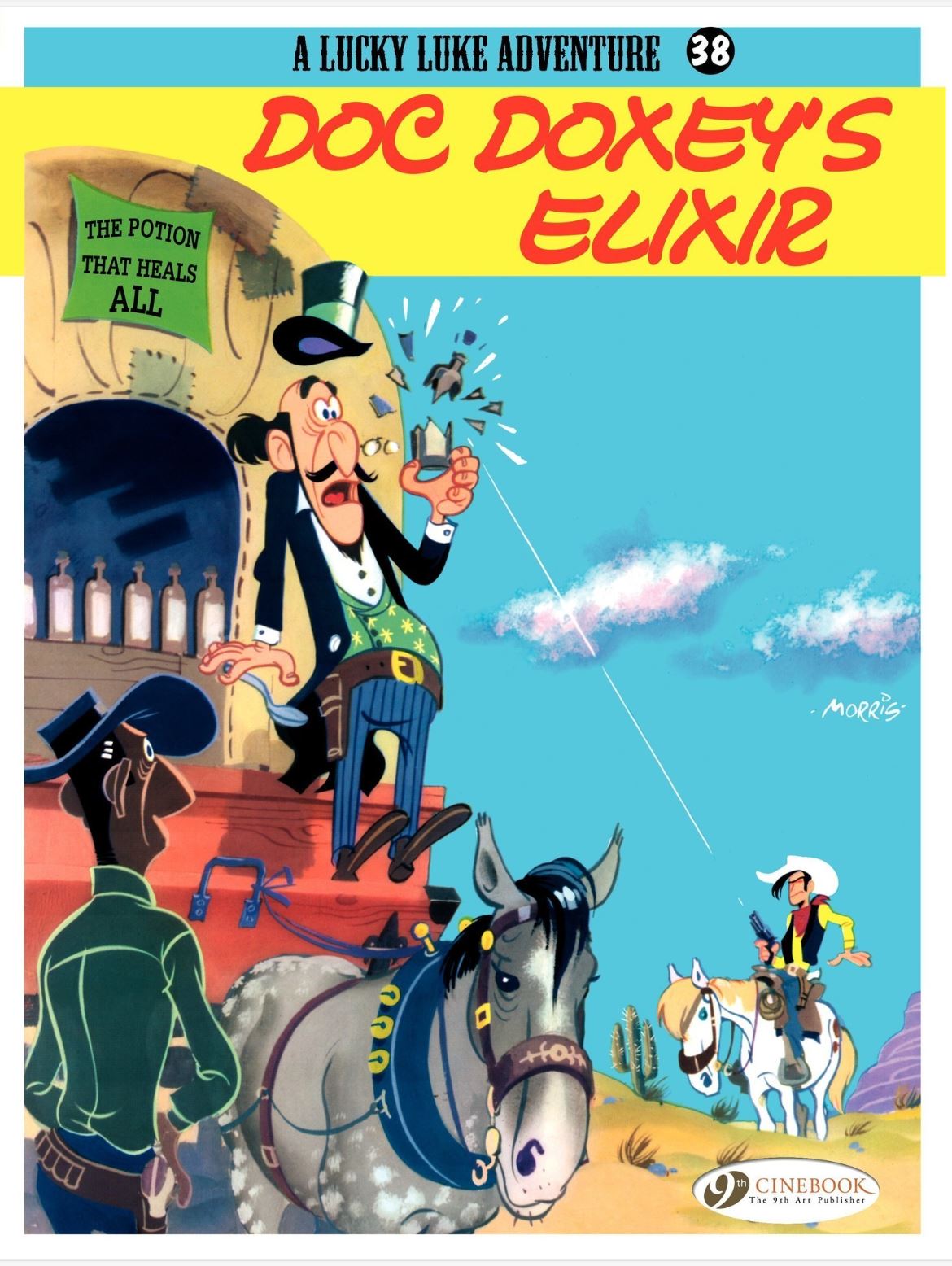
By Morris, translated by Erica Jeffrey (Cinebook)
ISBN: 978-1-84918-141-6 (Album PB/Digital edition)
Doughty, dashing and dependable cowboy “good guy” Lucky Luke is a rangy, implacably even-tempered do-gooder able to “draw faster than his own shadow”. He amiably ambles around the mythic Old West, having light-hearted adventures on his petulant and rather sarcastic wonder-horse Jolly Jumper.
Over nine decades, his exploits have made him one of the top-ranking comic characters in the world, generating upwards of 85 individual albums and spin-off series like Kid Lucky and Ran-Tan-Plan, with sales thus far totalling upwards of 300 million in 30 languages. That renown has translated into a mountain of merchandise, toys, games, animated cartoons, TV shows and live-action movies and even commemorative exhibitions. No theme park yet, but you never know…
Originally the brainchild of Belgian animator, illustrator and cartoonist Maurice de Bévère (“Morris”) and first – officially – seen in Le Journal de Spirou’s seasonal Annual L’Almanach Spirou 1947, Luke actually sprang to (un-titled) laconic life in mid-1946, before inevitably ambling into his first weekly adventure ‘Arizona 1880’ on December 7th of that year.
Morris was one of “la Bande des quatre”– The Gang of Four – comprising Jijé, Will and Franquin: leading proponents of a fresh, loosely free-wheeling artistic style known as the “Marcinelle School”. It came to dominate Le Journal de Spirou in aesthetic contention with the “Ligne Claire” style favoured by Hergé, E.P. Jacobs and other artists in Le Journal de Tintin. In 1948 said Gang (all but Will) visited America, meeting US creators and sightseeing. Morris stayed for six years, befriended René Goscinny, scored work at newly-formed EC sensation Mad and constantly, copiously, noted and sketched a swiftly vanishing Old West.
Working solo until 1955 (with early script assistance from his brother Louis De Bevere), Morris crafted nine albums – of which today’s was #7 – of affectionate sagebrush spoofery before teaming with old pal and fellow transatlantic émigré Goscinny. With him as regular wordsmith, Luke attained dizzying, legendary heights starting with Des rails sur la Prairie (Rails on the Prairie) which began serialisation on August 25th 1955.
In 1967, the six-gun straight-shooter switched sides, joining Goscinny’s own magazine Pilote in La Diligence (The Stagecoach). Goscinny co-created 45 albums with Morris before his untimely death, whereupon Morris soldiered on both singly and with other collaborators. He went to the Last Roundup in 2001, having drawn fully 70 adventures, plus numerous sidebar sagebrush sagas crafted with Achdé & Laurent Gerra, Benacquista & Pennac, Xavier Fauche, Jean Léturgie, Jacques Pessis and more, all taking their own shot at the venerable vigilante.
Lucky Luke has a long history in Britain, having first pseudonymously amused and enthralled young readers during the late 1950s, syndicated to weekly anthology Film Fun. He later rode back into comics-town in 1967 for comedy paper Giggle, using nom de plume Buck Bingo. And that’s not counting the many attempts to establish him as a book star starting with Brockhampton Press in 1972 and continuing via Knight Books, Hodder Dargaud UK, Ravette Books and Glo’Worm, until Cinebook finally found the right path in 2006.
As L’elixir du Docteur Doxey, today’s yarn spanned December 11th 1952 to 8th October 1953 when originally serialised in LJdS #765-808. The extended serial was then compiled as the seventh annual Lucky Luke album: published in November 1955, with successive volumes launching every year thereafter in that month.
Doc Doxey’s Elixir (entitled “Lucky Luke and Doc Doxey” on the opening page) relates the predatory journeys of a charlatan physician dispensing disgusting and often lethal liquid cure-alls, aided and abetted by his athletic stooge Scraggy. He gulls the public with disguises, near-miraculous instantaneous “recuperations” and equally fast exits.
Their pernicious peregrinations come to an end after poisoning the frontier town of Green Valley, putting dogged do-gooder Lucky on their trail – a long, perilous and relentless pursuit packed with classic and episodic chase gags. Said hunt concludes with the sneaky snake oil peddler behind bars. Of course, he doesn’t stay there long as sequel saga ‘Manhunt’ details his cunning escape, a change of identity – but not modus operandi – and an ultimately unsuccessful plot to murder the wandering cowboy…
Ideal for older kids who have gained a bit of historical perspective and social understanding – although the action and slapstick situations are no more contentious than any Laurel and Hardy film, Chuckle Brothers skit and whatever TikTok clip the waifs of the coming generation (Gen Eric?) titter to – these early exploits are a grand old hoot in the tradition of Destry Rides Again or Support Your Local Sheriff, superbly executed by a master storyteller, and a wonderful introduction to a unique genre for modern kids who might well have missed the romantic allure of the Wild West that never was…
© Dargaud Editeur Paris 1971 by Goscinny & Morris. © Lucky Comics. English translation © 2012 Cinebook Ltd.
